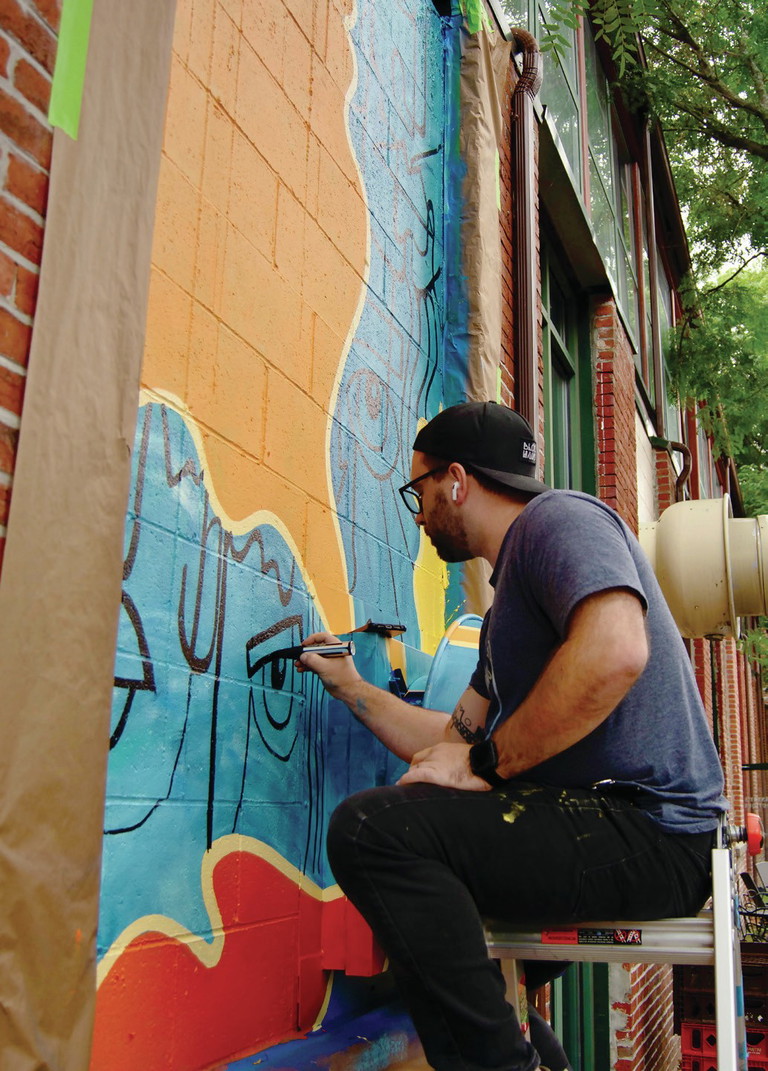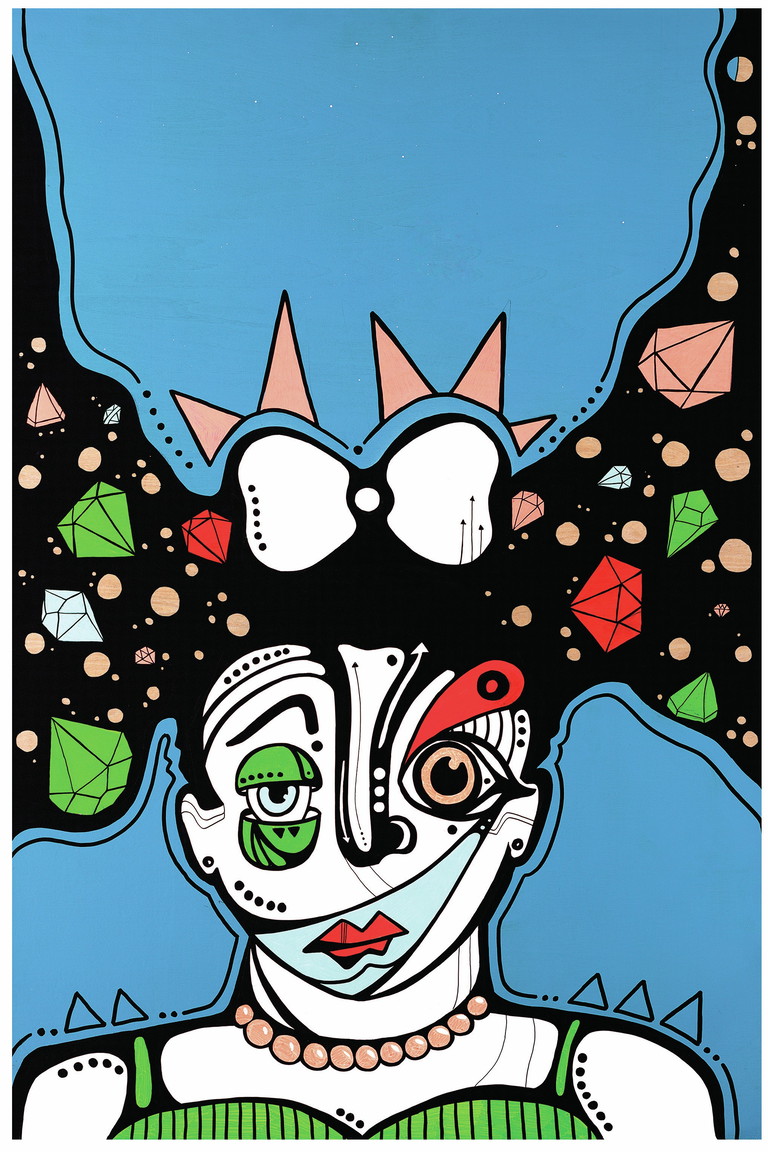CONTEMPORARY ART IN CONTEXT
Expressing Connection
JACOB GINGA VISUAL ARTIST AND ART EDUCATOR

Jacob Ginga works on his mural We Share One Sky for the Newburyport Art Associationʼs mural initiative, Newburyport, Massachusetts, 2023. Image courtesy of the artist.
Jacob Ginga is an art educator, painter, printmaker, and street artist. His passion for art and desire to connect with others are vital components of his practice. His works, even when completely nonobjective abstractions, such as Brackish Waters (p. 51), employ a diverse visual language that invites viewers to contemplate the narratives inherent in all of Gingaʼs work, though he rarely delivers definitive statements.
A full-time art educator, Ginga is as passionate about teaching art as he is about making his own. He initially adopted the pseudonym “MakerJake” to mask his social media presence from his students, but now he uses his true identity.
Engaging Narratives
Ginga combines themes of relationships, growth, and struggle with personal experiences and emotions. Although most of his works focus on universal concepts, he believes emotions are unique to each individual and reflect our shared humanity. His mural, We Share One Sky (this page), expresses this idea, with an emphasis on the “we” in its title.
Jacob paints his mural Sail Above the Ships. Image courtesy of the artist.
Jacob Ginga, We Share One Sky, completed mural, 2023. Images courtesy of the artist.
Ginga’s mural practice begins by engaging the community where the mural will be located, building relationships with the people and learning about their lives before creating a design intended to uplift the neighborhood.
Boiling Point (p. 51) explores an intense emotional experience, using vivid colors to heighten the intensity in a complex series of facets reminiscent of Picasso’s (1881–1973) Guernica.
Art History Connections
Ginga’s work draws on various aesthetics, from realism to abstraction. The layering, fracturing, and faceting of forms in Gingaʼs work are reminiscent of Cubism and Rayonism. His prints and paintings reflect the street art seen in his public murals. His fragmented portraits are influenced by Jean-Michel Basquiat (1960–1988), and augmented by rich, personal fantasy as seen in the work of Paul Klee (1879– 1940) and Margo Humphrey (b. 1942).
Jacob Ginga, Brackish Waters. Image courtesy of the artist.
Jacob Ginga, Love Letters. Image courtesy of the artist.
Jacob Ginga, Nesting (You Are More), 2023. Mural created for the El Punto Urban Art Museum, Salem, Massachusetts. Image courtesy of the artist.
About the Artist
Jacob Ginga was born into an artistic family in Massachusetts. He explored photography in high school and college, gradually shifting to street art and art education. He holds a BFA in art education from UMass Dartmouth, and an MA Ed from Northeastern University, Boston. In 2020, he was awarded Elementary Art Educator of the Year by the Massachusetts Art Education Association. He currently teaches elementary art in Weston, Massachusetts, and creates art throughout the state.

The Future Is Female. Image courtesy of the artist.
ARTIST Q&A
What are some of the biggest influences on your work?
JG: I’ve always considered my work to be narrative in nature; while many are not associated with specific stories, my pieces are deliberately crafted to initiate meaningful conversations. Rather than delivering definitive statements, my intention is to spark thoughtful dialogues. Conceptually, my art draws inspiration from my personal experiences, emotions, and a passion for teaching and sharing insights. Visually, my work encompasses a wide spectrum, reflecting influences from digital design, street art culture, music, and patterns. The combination of these influences creates a diverse visual language that serves as a platform for engaging viewers in meaningful and open-ended discussions.
How has your art evolved over time?
JG: Although I come from a family of artists, silversmiths, seamstresses, and woodworkers, my true love of art didnʼt develop until my early teens. The challenges posed by my ADHD hindered me from dedicating the necessary time and effort to bring the images in my mind to life. A tumultuous upbringing introduced me to the comforting embrace of punk music, revealing the beauty of connecting with others through shared experiences and trauma. Lacking a natural talent for music, I turned to visual communication as an outlet for my social anxiety. Photography served as my initial venture, capturing the essence of punk concerts, the punk community, and the world around me. I often describe photography as a gateway into other art forms. Photography let me share with the world, but I wanted to make my mark on it. I started making stickers from post office shipping labels and quickly scaled up to designing t-shirts. Even then, every design was an attempt to start a conversation or connect with someone feeling like me.
Entering art school, I chose a photography major. Despite concerns from my practical engineer father, I pursued my passion with his support. While in New Bedford and studying in Italy, my focus shifted toward street art and education. I discovered that my love for sharing and connecting through art was intricately tied to educational concepts. Building strong relationships with professors fueled my desire to create similar connections with my future students, and I switched to the art education program.
My primary mediums now include painting, printmaking, and incorporating found objects. Each chapter of my life provides not only a medium but a wealth of experiences that fuel concepts and creativity. Every piece I create, whether a portrait or an animal, channels my love for conversation and my need for connection. Finally, my artistic journey takes its newest turn with public art. In a full-circle moment, my art now takes a backseat to the communities it serves and the people I meet. I approach murals without covetousness or selectiveness; they are vehicles for change and love.
Where do you get your inspiration for color?
JG: Many of my designs and sketches undergo multiple color versions before I settle on a scheme. The color choices often align with the mood or idea of the painting, reflecting either the subjectʼs realistic colors or my intuitive selection process. Sometimes, I blindly experiment and keep changing colors until I find a combination that resonates.
In certain instances, I draw inspiration from historical artists, especially when exploring concepts like grief and loss. Researching paintings related to my themes, Iʼve found value in borrowing color choices from artists such as Basquiat. I recently used his colors from Untitled: Fishing in my piece Creativity through Discovery, where vibrantly colored lizards symbolize the joy of discovering salamanders under rocks during childhood.
What advice do you have for aspiring young artists?
JG: I generally say “Make [bad] art. And when you are done, make some more!” Society and Hollywood often present unrealistic images of artists as flawless and inherently skilled. In reality, I create many more paintings that donʼt quite hit the mark than those that succeed. For me, itʼs all about embracing the journey and the creative process. If one out of every ten paintings I create turns out to be a success, thatʼs a win in my book. Interestingly, the pieces I personally consider most successful are often the ones that others might not appreciate. The key is to keep making art as if your life depends on it and enjoy the evolving process.
Jacob Ginga, Boiling Point. Image courtesy of the artist.
DISCUSSION
Introduce students to the concept of Relational Art, or art that relies heavily on the viewer’s participation. Ask them to think of examples they may have seen or encountered. After some discussion, ask how many of them have seen a mural. Ask: Did it interrupt what you were doing? Did it provoke you to react emotionally or think differently about something? Next, introduce Ginga’s work, emphasizing how murals and street art can impact the community where they are placed.
STUDIO EXPERIENCES
RESOURCES
Artist Website: mkr.gallery
Artist Instagram: @makerjake
External Links Disclaimer: The content in SchoolArts magazine represents the views of individual authors and artists, selected for publication by the editorial team. The resources provided are to support the teaching of art in a variety of contexts, and therefore, links to external sources are included. As such, any linked content is not monitored by SchoolArts and should be previewed by a professional before sharing with students.
Written by Karl Cole, Art Historian and Curator of Images at Davis Publications, and Robb Sandagata, Digital Curriculum Director and Editor at Davis Publications. kcole@davisart.com
Preview Mode - Subscribe to unlock full content


SchoolArts Magazine
Inspiring Creativity Since 1901
A national art education magazine committed to promoting excellence, advocacy, and professional support for educators in the visual arts.
Categories
Explore our inspiring content by topic